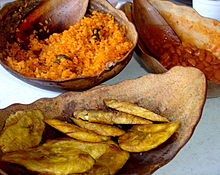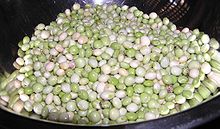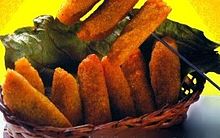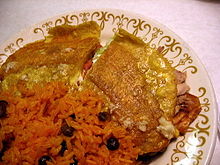- Puerto Rican cuisine
-
Puerto Rican cuisine has its roots in the cooking traditions and practices of Europe (Spain), Africa and the Amerindian Taínos. In the latter part of the 19th century the cuisine of Puerto Rico was greatly influenced by the United States in the ingredients used in its preparation. Puerto Rican cuisine has transcended the boundaries of the island and can be found in several countries outside the archipelago.
Contents
History
The cuisines of Spain, Taíno and Arawaks Amerindians, and parts of the African continent have had an impact on how food is prepared in Puerto Rico. Although Puerto Rican cooking is somewhat similar to both Spanish and Latin American cuisine, it is a unique tasty blend of influences, using indigenous seasonings and ingredients. Locals call their cuisine "cocina criolla[1] The traditional Puerto Rican cuisine was well established by the end of the nineteenth century. By 1848 the first restaurant, La Mallorquina, opened in Old San Juan. El Cocinero Puertorriqueño, the island's first cookbook was published in 1849.[2]
Taino Amerindian influences
From the diet of the Taíno (culturally related with the Mayas & Caribs of Central America and the Caribbean),[3] and Arawak people come many tropical roots and tubers like yautía (taro) and especially Yuca (cassava), from which thin cracker-like casabe bread is made. Ajicito or cachucha pepper, a slightly hot habanero pepper, recao/culantro (spiny leaf), achiote (annatto), peppers, ají caballero (the hottest pepper native to Puerto Rico), peanuts, guavas, pineapples, jicacos (cocoplum), quenepas (mamincillo), lerenes (Guinea arrowroot), calabazas (tropical pumpkins), and guanabanas (soursops) are all Taíno foods. The Taínos also grew varieties of beans and some maíz (corn/maize), but maíz was not as dominant in their cooking as it was for the peoples living on the mainland of Mesoamerica. This is due to the frequent hurricanes that Puerto Rico experiences, which destroy crops of maíz, leaving more safeguarded plants like conucos (hills of yuca grown together).[4]
Spanish / European influence
See: Spanish Cuisine
Spanish / European influence is also seen in Puerto Rican cuisine. Wheat, garbanzos, capers, olives, olive oil, black pepper, onions, garlic, cilantrillo (or cilantro), oregano, basil, sugarcane, citrus fruit, eggplant, ham, lard, chicken, beef, pork, and cheese all came to Borikén (Puerto Rico's Amerindian name) from Spain. The tradition of cooking complex stews and rice dishes in pots such as rice and beans are also thought to be originally European (much like Italians, Spaniards, and the British).[5] Early Dutch, French, Italian, and Chinese immigrants influenced not only the culture but Puerto Rican cooking as well. This great variety of traditions came together to form La Cocina Criolla.
African influence
Coconuts, coffee (brought by the Arabs and Corsos to Yauco from Kafa, Ethiopia), okra, yams, sesame seeds, gandules (pigeon peas in English) sweet bananas, plantains, other root vegetables and Guinea hen, all come to Puerto Rico from Africa. African slaves introduced the deep-frying of food.[6]
United States influence
See: Cuisine of the United States
The American (U.S.) influence in the way that Puerto Ricans cook their meals came about after Puerto Rico became a territory of the United States as a result of the Treaty of Paris of 1898. The most significant has to do with how people fry food. The early Spaniards brought olive oil for cooking and frying, but importing it from Spain made it very expensive, and cooks on the Island shifted over to lard which could be produced locally. For 50–60 years, corn oil produced in the United States took the place of lard for making cuchifritos and alcapurrias.
Galletas de soda (soda crackers in tins, popularly known as export sodas from a popular brand name) are an American product of the 19th and early 20th centuries that reproduce the crunchy texture of the earlier casabe bread and can be kept crunchy (in the tins) in high tropical humidity.
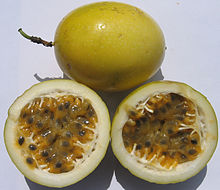 Parcha, Puerto Rican name for Passiflora edulis, passion fruit.
Parcha, Puerto Rican name for Passiflora edulis, passion fruit.
American bacon has also played a big part in Puerto Rican cuisine. Used in rice, stewed beans and to stuff mofongo and meats such as whole chicken and the breast. Bacon in Puerto Rico has found its way into traditional foods such as arroz con gandules and potato salad.
South America influence
Other foods native to Latino America were brought to the island with the Spanish trade, such as cocoa, avocado, tomatoes, chayote, papaya, bell peppers and vanilla from Mexico and Central America. Potatoes and passion fruit were also brought over by the Spanish or Portuguese from Peru and Brazil.
Other influence
Panapén (breadfruit) was first imported into the British Caribbean colonies from the South Pacific as cheap slave food in the late 18th century. After spreading throughout the Antilles, panapén has also become an indispensable part of the Puerto Rican repertoire, both in puddings and crunchy, deep-fried tostones.
Canned Corned Beef stew
Pasta - Using Puerto Rican seasonings and meats.
Salchichas (canned Vienna sausages) - They were introduced in 1898. Today, they are scrambled with eggs and cooked in other dishes. Very popular cooked in rice as Arroz con Salchichas or stewed separately and served with white rice as Salchichas Guisadas (sausage stew).
Basic Ingredients
 red kidney beans (habichuelas coloradas)
red kidney beans (habichuelas coloradas)
Grains and Legumes
- Black beans
- Coffee
- White beans (navy beans)
- Lima beans
- Corn
- Gandules - Pigeon peas
- Garbanzo beans
- Green beans
- Green peas
- Kidney Beans
- Lentils
- Pink beans
- Pinto beans
- Rice
Herbs
- Basil/Albahaca
- Bay leaves - Laurel
- Cilantro cilantrillo, recao de España
- Marjoram/Mejorana
- Mint/Menta
- Orégano brujo - Plectranthus amboinicus. Puerto Rican wild oregano. This oregano, with its distinctive pungent aroma, grows wild on the island. It is mainly used dry and is a key ingredient in adobo seco and adobo mojado.
- Parsley/Perejil
- Culantro - Eryngium foetidum. Recao del monte, Mexican coriander - 10 times the flavor of Cilantro.
- Sage/Salvia
- Tarragon/Estragón
- Caribbean thyme/Tomillo - Same flavor as English thyme but 10 times stronger.
Starchy tropical tubers
 Yuca, Puerto Rican name for cassava.
Yuca, Puerto Rican name for cassava.
- Apio - Root vegetable (from the legume Apios tuberosa / Apios americana), eaten like potatoes. Not to be confused with celery.
- Batata - (Sweet Potato) - Batata
- Malanga
- Ñame
- Potatoes
- Yautía - Taro
- Yuca - Similar to a potato but more starchy. Usually boiled or Fried.
Vegetables
 Ajicitos / Cachucha chili peppers
Ajicitos / Cachucha chili peppers
- Ajicitos - Capsicum chinense - Better known as Ají Dulce; Habanero Pepper's mild cousin.
- Ají caballero - A very hot pepper native to Puerto Rico. Also known by Puerto Rican Jelly Bean Hot Chili Pepper.
- Asparagus
- Bell Peppers
- Cabbage
- Calabash
- Carrot
- Cauliflower
- Cubanelle peppers
- Chayote
- Cucumber
- Eggplant (Berenjena)
- Green onions
- Lettuce
- Onion
- Shallot
- Watercress
- West Indian pumpkin
Meats and Poultry
- Beef
- Butifarra - Puerto Rican grill sausage.
- Chicken
- Chorizo
- Corned beef
- Duck
- Goat
- Geese
- Guinea hen
- Ham
- Iguana
- Lamb
- Longaniza
- Morcilla - Moronga
- Oxtail
- Pigeon
- Pork
- Rabbit
- Salchichon - Puerto Rican salami
- Turkey
Seafood and shellfish
- Chapín (Trunkfish)
- Chillo (Pargo) - Puerto Rican Red Snapper
- Clams
- Cod
- Conch
- Dried and salted cod
- Marlin
- Mahi-mahi (Dorado)
- Mussel
- Octopus
- Oysters
- Salmon
- Shrimp
- Spiny lobster
- Squid
- Tuna fish
- West Indian Great Land Crab
Fruits
Fresh tropical fruit is important in the traditional daily diet in Puerto Rico
 Aguacate / Avocado
Aguacate / Avocado
- Acerola cherry
- Anón - Sugar apple
- Avocado
- Bananas
- Bitter orange
- Caimito - Chrysophyllum cainito
- Chironja - The Chironja (Orangelo) is a combination of orange and pomelo, the original name for the grapefruit, and is a native fruit of Puerto Rico.
- Coconut
- Corazón - Custard apple
- Cucumber
- Frambuesas - Puerto Rican raspberries (Rubus rosifolius)
- Grapefruit
- Guanábana
- Guava
- Guineos niños - Lady - Finger bananas
- Jackfruit
- Jobo - A refreshing orangy yellow fruit
- Key lime
- Lemons
- lime
- Mamey
- Quenepa
- Mandarin Orange
- Mango
- Nance
- Okra
- Orange
- Papaya
- Passion fruit
- Pineapple
- Pomarosa - Appelroo (Tropical apple / Syzygium malaccense)
- Pomegranate
- Red Banana
- Sea Grape
- Soursop
- Starfruit - Carambola
- Tamarind
- Tomatoes
- Watermelon
Starchy Fruits
- Breadfruit - Known in Puerto Rico as Panapén.
- Green bananas They are occasional fare, whether deep-fried and mashed as tostones, or boiled and seasoned with escabeche.
- Plantains
Spices and Seasonings
- Adobo mojado - fresh garlic, salt, black pepper, olive oil, whole dried orégano brujo, wine vinegar or citrus juice and sometimes fresh thyme.
- Adobo seco - garlic powder, onion powder, ground orégano brujo, salt, black pepper, and sometimes dried citrus zest.
- Adobo con cumino - cumin, garlic powder, salt, and white pepper. Dried thyme can also be added.
- Ajilimójili sauce - a very garlicky hot & spicy salsa
- Alcaparrado - A mix of green olives, peppers, and capers
- Allspice
- Anise seeds
- Achiote or Bija - annatto (Bixa orellana)
- Annatto Oil - olive oil, oil or lard infused with annatto pods. It is used to and flavor many dishes and color food. Sometimes a whole chili pepper is add.
- Black pepper
- White pepper
- Dried Cayenne pepper
- Cloves
- Cinnamon
- Cumin
- Garlic
- Ginger
- Mojito isleño
- Mojo - a herb sauce of finely chopped cilantro or parsley with garlic, citrus, vinegar and olive oil. Onions and butter are sometimes also added.
- Nutmeg
- Paprika
- Pique verde boricua - Green hot sauce
- Picadillo a la puertorriqueña
- Pique criollo - Puerto Rican hot condiment
- Recaíto - A green cooking base mix of cilantro, yellow Spanish onion, recao / culantro, garlic, green bell pepper and green Ajicitos (Cachucha peppers).
- Saffron
- Sazón - a seasoning mix consisting of cilantro flakes, garlic powder, ground cumin, salt and achiote powder. Achiote can be subsisted with paprika or saffron.
- Sazón liquido - a liquid mix of achiote oil, garlic, cilantro, cumin, salt and bay leaves.
- Sofrito - A mixture of ajicitos (cachucha peppers), green cubanelle peppers, plum tomato, roasted red cubanelle pepper, cilantro, yellow Spanish onion, recao / culantro and garlic.
- Star anise
- Vanilla
Puerto Rican Dishes
Puerto Rican dishes are well seasoned with combinations of flavorful spices. The base of many Puerto Rican main dishes involves sofrito, similar to the mirepoix of French cooking, or the "trinity" of Creole cooking. A proper sofrito is a sauté of freshly ground garlic, tomatoes, onions, recao/culantro, cilantro, red peppers, cachucha and cubanelle peppers. Sofrito is traditionally cooked with olive oil or annatto oil, tocino (bacon), salted pork and cured ham. A mix of stuffed olives and capers called alcaparrado are usually added with spices such as bay leaf, cumin, sazón and adobo.
Staples
There are plenty of them. Here are just a few:
- Albondigón - Puerto Rican meat loaf.
- Alcapurrias - made from a mixture of mainly yautía and may contain ground squash, plantains, green banana and other starchy tropical tubers filled with ground meat or seafood and deep fried in oil.
- Almojábanas - cheese-flavored rice fritters.
- Arañitas - a combination of fried ripped and unripened shredded plantain, seasoned with salt, garlic and spices. Squash and other tubers can also be added.
- Arepas / Domplines - These are fried rounds of flour-based dough. Sometimes they can contain coconut (known as arepas de coco). They are sometimes stuffed with seafood. This dish is particular to the Eastern and Southern parts of Puerto Rico.
- Arroz con habichuelas - Literally "rice and beans", this dish is so common that the phrase "rice and beans" means essentially the same as "our daily bread" in northern countries. Pink and red beans are the most common. The beans are cooked together with recaito base, stock, chunks of ham, potatoes and/or calabaza (tropical pumpkin), alcaparrado, tomatoes sauce (to thicken stew), and flavored with spices. When done the beans are then ladled over a mound of rice. Sticky medium-grained rice is more popular in Puerto Rico than long grain rice.
 Mofongo
Mofongo
- Arroz con pollo - Chicken and rice cooked in the same pot. Traditionally chicken is seasoned with adobo. Then placed in a pot with rice, annatto oil, sofrito, stock, beer, olives, and capers.
- Bacalaítos - These are fritters made from a pancake-like batter containing codfish, flour, and seasoning.
- Buñuelos - Yam fritters.
- Canoas - Ripe plantain "canoes" stuffed with ground meat and covered with melted cheese.
- Carne Guisada - Puerto Rican beef stew
- Chicharrón
- Cuajitos en salsa (Buche) - Puerto Rican dish made with pork belly in a red hot sauce
- Empanadas - Breaded steak (beef / turkey / chicken / veal)
- Empanadillas de carne / mariscos / queso / guava - Meat, seafood, cheese, or fruit turnovers usually called "empanadas" in other Spanish-speaking countries. On the eastern side of the island empanadillas are known as pastelillos, although pastelillo also refers to a pastry turnover.
- Escabeche
- Fricasé - Hearty and spicy (chicken / turkey / rabbit or goat) stew with potatoes, beer / white dry wine or red wine, olives, capers, peas & carrots.
- Guanimes - Semi-sweet tamales, wrapped in banana leaves.
- Jibarito - Plantain sandwich (traditionally made with steak or pork).
- Mofongo - a popular dish made from fried green plantains or fried yuca, seasoned with garlic, olive oil and pork cracklings, then mashed. Mofongo is usually served with a fried meat and a chicken broth soup.
- Mondongo (Menudo) - Pork tripe stew.
- Morcilla - A type of spicy and hot blood sausage.
- Piononos - Fried filled ripe plantain rolls.
- Pollo frito - Puerto Rican style fried chicken
- Rabo encendido - Spicy and hot oxtail stew.
- Salmorejo - Crabmeat stew.
- Sancocho de patitas - Hearty pork feet stew with starchy vegetables, plantains, and Garbanzo beans.
- Sorullos - Fried corn meal logs (much like little tamales), sometimes stuffed with cheese.
- Taquitos - Puerto Rican "Chimichanga".
- Tortilla - Puerto Rican style omelette.
- Seafood - On certain coastal towns of the island, such as Luquillo, Fajardo, and Cabo Rojo, seafood is quite popular, although much of it is imported. Only a tiny number of fishermen ply the waters off Puerto Rico today, and their catch never leaves their seacoast towns. The fact that the island sits next to the deepest part of the Atlantic means there is no wide continental shelf to foster a rich offshore fishery; neither are there any large rivers to dump extra nutrients into the sea that could build up a fish population. Popular seafood include bacalao (codfish), chapín (tropical fish), pulpo (octopus, not always canned), carrucho (conch), camarones (shrimp), langosta (lobster) (most commonly caught in the surrounding waters), and jueyes (crabs).
- Tostones - twice fried plantains originated in the south of Puerto Rico. They are now a popular dish all over Latin America and Caribbean.
 Puerto Rican cuisine has several recipes for flan including vanilla, coconut cream, pineapple, pumpkin, carrot, cheese and many more.
Puerto Rican cuisine has several recipes for flan including vanilla, coconut cream, pineapple, pumpkin, carrot, cheese and many more.
- Quesitos - cheese pastries
Holiday dishes
- Arroz con dulce - Puerto Rican rice pudding. It is notable that in Puerto Rico rice pudding is made with coconut milk and coconut cream as opposed to only bovine milk or cream used elsewhere. Other flavors in to Arroz con Dulce include cloves, ginger, raisins soaked in rum, vanilla, cinnamon, brown or white sugar, heavy cream or milk and sometimes lemon zest.
- Arroz con gandules - it is a yellow-rice-and-pigeon-pea dish with alcaparrado (capers and olives stuffed with red peppers), and pieces of meat (bacon, smoked ham, smocked turkey or chorizo). The spices and seasoning usually include of cumin, bay leaf, annatto oil, sofrito, banana leaf, dry oregano, thyme, and stock. It is part of Puerto Rico's national dish along with pig roast.
- Coquito - A popular Christmastime drink is coquito, an eggnog-like rum and coconut milk-based homemade beverage. The holiday season is also a time that many piñas coladas are prepared, underscoring the combination of pineapples and coconuts seen in Puerto Rican cuisine.[7]
- Ensalada de pulpo - Octopus salad is the most common salad on a Puerto Rican Christmas tables. Common ingredients added are black olives, orégano brujo, garlic, olive oil, cilantro, peppers, red onion, lemon juice and red wine vinegar or white wine vinegar.
- Pasteles - For many Puerto Rican families, the quintessential holiday season dish is pasteles, which English-speakers often literally translate to "pies".
Pasteles are not a sweet pastry or cake, but a soft dough-like mass wrapped in a banana or plantain leaf and boiled. In the center of the dough are choice pieces of chopped meat, shellfish, chicken, raisins, spices, capers, olives, sofrito and often garbanzo beans. Puerto Rican pasteles are similar in shape, size, and cooking technique to Latin American tamales. The dough in a tamal is made from corn meal; while in a Puerto Rican pastel it is made from either green bananas and/or starchy tropical roots. The wrapper in a tamal is a corn shuck or a banana leaf; the wrapper in a Puerto Rican pastel is a banana leaf. Pasteles also use different spices than tamales. The making of pasteles is a labor-intensive social activity. Many family members will get together for hours or days to make dozens to hundreds of pasteles to share with friends and loved ones. Pasteles from the Island are often shipped overseas packed in dry ice during the long Christmas season. They are received as a nostalgic, much treasured gift.
- Pig roast - Pork is central to Puerto Rican holiday cooking, especially the lechón (spit-roasted piglet). Holiday feasts might include several pork dishes, such as pernil (a baked fresh pork shoulder seasoned in adobo mojado), morcilla (a black blood sausage), tripa (tripe), jamón con piña (ham and pineapple), gandinga (stewed pork innards) and chuletas ahumadas (smoked cutlets).
- Stuffed Turkey - From November to January Puerto Ricans enjoy holiday parties and large family dinners almost daily, starting with the Thanksgiving turkey which is seasoned with adobo mojado and stuffed with mofongo or ground beef and/or pork mixture containing almonds, raisins, olives, hard boiled eggs, tomatoes, and garlic. Instead of the thin slices seen in the North, a baked turkey in Puerto Rico is often cut into large blocks or chunks to be served on a plate. Rice is a mandatory course in dishes such as Arroz con Gandules (rice with pigeon peas), Arroz con Tocino (rice with bacon), Arroz Mampostea'o, and the sweet dessert Arroz con Dulce (rice pudding).
- Sweets - Sweets are common in Puerto Rican cuisine. During the holidays, the most popular are desserts such as Arroz con Dulce (sweet rice pudding), Budín de Pan (bread pudding), Bienmesabe (little yellow cakes soaked in coconut cream), Brazo Gitano - Puerto Rican style sponge cake with cream and / or fruit filling), Buñuelos de viento - Puerto Rican wind puffs soaked in a vanilla, lemon and sugar syrup), Barriguitas de Vieja (deep-fried sweet pumpkin fritters), Natilla, Tembleque (coconut pudding), Flan (egg custard), Bizcocho de Ron (rum cake), Mantecaditos (Puerto Rican shortbread cookies), Polvorones (a crunchy cookie with a dusty sweet cinnamon exterior), Turrón de Ajónjolí (a toasted sesame seed bar bound together by caramelized brown sugar), Mampostiales (a very thick, gooey candy bar of caramelized brown sugar and coconut chips, challenging to chew and with a strong, almost molasses-like flavor), Dulce de Leche (milk and key lime peelings' caramel pudding), Pastelillos de Guayaba (guava pastries), Besitos de Coco (coconut kisses), Tarta de Guayaba (guava tarts), and Tortitas de Calabaza (pumpkin tarts).
Puerto Rican food outside the archipelago
- Cuchifritos - In New York, cuchifritos are quite popular. "Cuchifritos", often known as "Puerto Rican soul food" includes a variety of dishes including but not limited to morcilla (blood sausage), chicharron (fried pork skin), patitas (pork feet), masitas (fried porkmeat), and various other parts of the pig prepared in different ways.
- Jibarito (Plaintain Sandwich) - In Chicago, El Jibarito is a popular dish.[citation needed] The word jíbaro in Puerto Rico means a man from the countryside, especially a small landowner or humble farmer from far up in the mountains. Jíbaro is a term strongly associated with preserving the traditional values and the culture of the Island. Typically served with Spanish rice, Jibaritos consist of a meat along with mayonnaise, cheese, lettuce, tomatoes and onions, all sandwiched between a fried plantain, known as a canoa (canoe). In the early 20th century, bread made from wheat (which would have to be imported) was expensive out in the mountain towns of the Cordillera Central, and jíbaros were made from plantains which are still grown there on the steep hillsides.
See also
Chefs
- Dora Romano - author of "Cocine Conmigo" written in 1970.
- Carmen Valldejuli - author of Cocina Criolla / Puerto Rican Cookery written in 1984.
- Berta Canabillas - author of Puerto Rican Dishes written in 1993.
- Daisy Martinez - author of Daisy Cooks: Latin Flavors That Will Rock Your World written in 2005 and Daisy: Morning, Noon and Night written in 2010. Television host of Daisy Cooks! on PBS and ¡Viva Daisy! on the food network.
- Oswald Rivera - author of Puerto Rican Cuisine in America: Nuyorican and Bodega Recipes written in 2002.
- Yvonne Ortiz - author of A Taste of Puerto Rico: Traditional and New Dishes from the Puerto Rican Community written in 1997.
- Maria Perez - author of Tropical Cooking Made Easy written in 2007.
- Recipes from La Isla: New & Traditional Puerto Rican Cuisine - written in 1995 by Robert Rosado & Judith Healey Rosado
- The spirit of Puerto Rican rum - written in 1992 by Blanche Gelabert
- Elizabeth B. K. Dooley - author of Puerto Rican Cook Book written in 1948.
- Homestyle Puerto Rican Cooking, Traditional Recipes with a Modern Touch, 2004, by Dr. Erisbelia Garriga
- Wilo Benet - author of Puerto Rico True Flavors and Puerto Rico Sabor Criollo both written in 2007. Competed on Top Chef Masters.
- Giovanna Huyke - Famous television chef
- Luis Antonio Cosme - Famous Puerto Rican actor and television chef
References
- ^ Welcome to Puerto Rico!
- ^ Ortiz, Yvonne. A Taste of Puerto Rico: Traditional and New Dishes from the Puerto Rican Community. Penguin group, 1997. P. 3
- ^ Taino and Mayas
- ^ Puerto Rico Culture: Food and Drinks
- ^ http://welcome.topuertorico.org/index.shtml
- ^ Puerto Rico: Grand Cuisine of the Caribbean by Jose Luis Diaz de Villegas
- ^ Puerto Rico: Grand Cuisine of the Caribbean by Jose Luis Diaz de Villegas
External links
- Puerto Rican Recipes
- The Rican Chef - Recipes from the cultural magazine El Boricua, Puerto Rico
- http://welcome.topuertorico.org/culture/foodrink.shtml
North American cuisine Sovereign states - Antigua and Barbuda
- Bahamas
- Barbados
- Belize
- Canada
- Costa Rica
- Cuba
- Dominica
- Dominican Republic
- El Salvador
- Grenada
- Guatemala
- Haiti
- Honduras
- Jamaica
- Mexico
- Nicaragua
- Panama
- Saint Kitts and Nevis
- Saint Lucia
- Saint Vincent and the Grenadines
- Trinidad and Tobago
- United States

Dependencies and
other territories- Anguilla
- Aruba
- Bermuda
- Bonaire
- British Virgin Islands
- Cayman Islands
- Curaçao
- Greenland
- Guadeloupe
- Martinique
- Montserrat
- Puerto Rico
- Saint Barthélemy
- Saint Martin
- Saint Pierre and Miquelon
- Saba
- Sint Eustatius
- Sint Maarten
- Turks and Caicos Islands
- United States Virgin Islands
Categories:- Puerto Rican cuisine
- Latin American cuisine
- Puerto Rican ingredients
- Caribbean cuisine
- Cuisine by nationality
Wikimedia Foundation. 2010.


